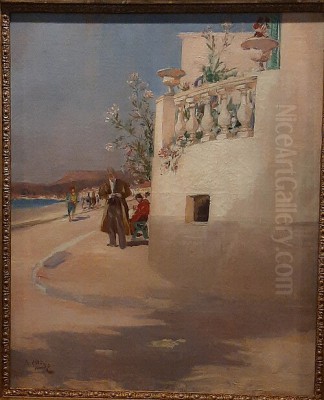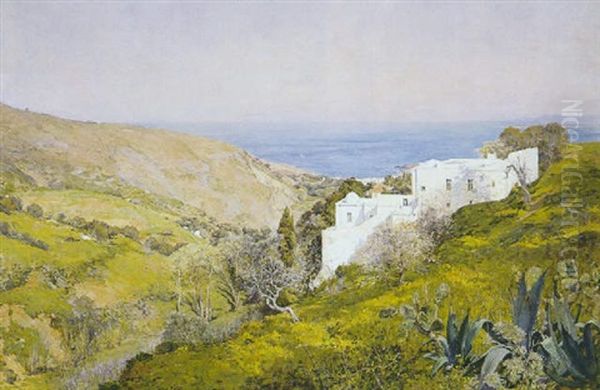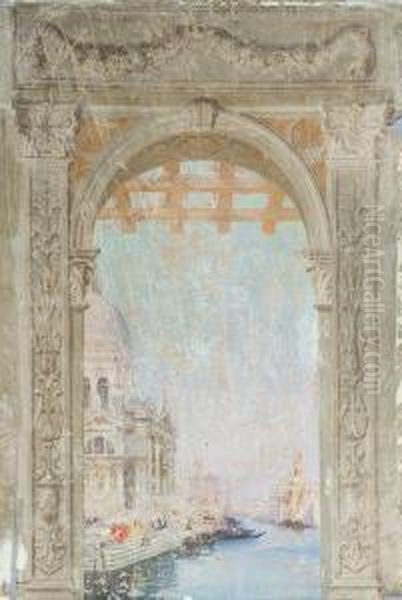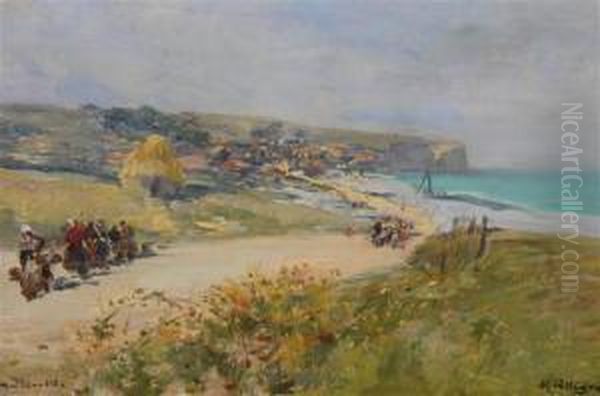
Raymond Allègre (1857-1933) stands as a significant figure in late 19th and early 20th-century French art, celebrated primarily for his evocative landscape paintings. Born in the vibrant port city of Marseille, the light and atmosphere of the Mediterranean deeply permeated his artistic vision. While often associated with Realism, his work incorporates distinct Impressionistic sensibilities, particularly in his treatment of light and colour, and also shows influences from the Orientalist movement. He dedicated much of his career to capturing the unique beauty of his native Provence, as well as the enchanting allure of Venice, leaving behind a rich legacy of works that continue to resonate with viewers today.
Early Life and Artistic Formation in Marseille and Paris
Raymond Marie Joseph Allègre was born in Marseille on August 28, 1857. His artistic inclinations emerged early, leading him to pursue formal training in his hometown. He enrolled at the École des Beaux-Arts de Marseille, a crucial step in honing his foundational skills. It was during this period in Marseille that he reportedly gained some experience as a teacher in local schools, although specific details about this phase of his life remain scarce in historical records. This early immersion in the artistic environment of Marseille was formative, exposing him to the intense light and characteristic landscapes of the South of France that would become central to his oeuvre.
During his studies in Marseille, Allègre formed important and lasting friendships with fellow artists who would also achieve recognition. Notably, he connected with Félix Ziem, a painter renowned for his atmospheric depictions of Venice and Constantinople, and Jean-Baptiste Olive, who would become celebrated for his paintings of the Marseille harbor and the Provençal coast. These early relationships likely fostered a shared passion for capturing the essence of the Mediterranean world.

Seeking to further his artistic education and engage with the vibrant art scene of the capital, Allègre moved to Paris. He gained admission to the prestigious École Nationale Supérieure des Beaux-Arts, the epicenter of academic art training in France. There, he had the invaluable opportunity to study under several influential masters of the time. His teachers included Jean-Paul Laurens, a prominent history painter known for his dramatic and meticulously researched compositions; Antoine Vollon, a master of still life and landscape painting admired for his rich textures and robust realism, sometimes compared to Chardin; and Léon Bonnat, a celebrated portraitist and academic painter known for his powerful realism and Spanish influences.
Under the guidance of these distinguished artists, Allègre refined his technical skills, mastering draftsmanship, composition, and the traditional methods favoured by the French Academy. While his teachers represented the more established, academic side of the art world—often seen in contrast to the burgeoning Impressionist movement—their rigorous training provided Allègre with a solid foundation upon which he would build his own distinct style. Even as he absorbed academic principles, the seeds of his later engagement with light and atmosphere, perhaps influenced by artists like Eugène Boudin known for his coastal scenes, were likely being sown.
The Lure of Provence: Capturing the Midi
Although his initial artistic endeavours, starting around 1875 when he was just eighteen, included painting landscapes in the Paris region and Normandy, Raymond Allègre’s artistic heart truly belonged to the South of France. He soon began to focus his attention almost exclusively on capturing the diverse and luminous landscapes of Provence. This region, with its ancient towns, rugged coastlines, sun-drenched fields, and unique quality of light, offered him endless inspiration.
His canvases frequently depict well-known Provençal locations. Martigues, a picturesque fishing town situated between the Étang de Berre and the Mediterranean Sea, was a particular favourite. Often referred to as the "Venice of Provence" due to its canals, Martigues provided Allègre with charming subjects: bustling quays, colourful fishing boats, reflections shimmering on the water, and the intimate atmosphere of its waterways. His work An Animated Quay in Martigues exemplifies his ability to capture the lively spirit of the town while bathing the scene in characteristic Mediterranean light.
Beyond Martigues, Allègre explored other areas of the Côte d'Azur and its hinterland. He painted views of Monaco and its surroundings, capturing the grandeur of the coastline and the deep blue of the sea. Cassis, with its dramatic calanques (rocky inlets) and charming port, also featured in his work. His depictions often emphasize the contrast between the azure water, the white limestone cliffs, and the vibrant green of the pine trees, rendered with a sensitivity to the changing effects of sunlight throughout the day.

Allègre's Provençal landscapes are not merely topographical records; they are imbued with a sense of place and atmosphere. He masterfully conveyed the intense heat of the midday sun, the cool tranquility of shaded groves, and the golden glow of late afternoon light. Works like Champ d'Olivier le soir (Olive Grove in the Evening) or Les Siestes (The Naps) suggest a deep connection to the rhythm of life in Provence, capturing moments of quietude and the region's timeless, almost poetic quality. His use of colour, often bright and saturated, and his increasingly free brushwork show the influence of Impressionism, yet he maintained a strong sense of structure and form rooted in his academic training.
Venetian Dreams and Orientalist Echoes
A significant journey in 1900 profoundly impacted Raymond Allègre's artistic trajectory: his visit to Venice. Like many artists before and after him, including his friend Félix Ziem and the British master J.M.W. Turner, Allègre was captivated by the unique beauty and romantic atmosphere of the Italian city. The interplay of light, water, and architecture in Venice offered a new, yet related, set of visual challenges and inspirations compared to his native Provence.
This trip sparked a prolific period of Venetian painting. Allègre produced numerous views of the city, capturing its famous landmarks like the Grand Canal, St. Mark's Square, and the Doge's Palace, as well as quieter, more intimate scenes of smaller canals and bridges. His Venetian works often emphasize the shimmering reflections on the water, the textures of weathered stone, and the dramatic effects of sunlight and weather. These paintings allowed him to explore themes of light and atmosphere in a different context, often with a heightened sense of romanticism.
The Venetian subjects, along with his depictions of North African scenes (even if sometimes painted from secondary sources or brief travels), connect Allègre to the broader artistic movement of Orientalism. This fascination with the 'Orient' – encompassing Italy, Spain, North Africa, and the Middle East – was prevalent in 19th-century European art. Artists like Eugène Delacroix, Jean-Léon Gérôme (who was Jean-Paul Laurens' teacher, creating an indirect link), and Eugène Fromentin travelled and depicted these regions, often emphasizing exoticism, vibrant colour, and dramatic light. While Allègre's focus remained primarily on landscape and cityscape rather than ethnographic detail, his choice of subjects like Venice and Algiers, and his emphasis on strong light and colour effects, align him with this popular trend.

His skill in evoking different locales was recognized through a prestigious commission for the famous restaurant "Le Train Bleu" located within the Gare de Lyon railway station in Paris. Opened in 1901, the restaurant was lavishly decorated with paintings celebrating the destinations served by the PLM (Paris-Lyon-Méditerranée) railway company. Allègre contributed two large decorative panels: one depicting Algiers and the other depicting Cassis. This commission placed him among a distinguished group of artists decorating the restaurant, including figures like Henri Gervex, Gaston La Touche, Albert Maignan, and fellow Provençal painter Frédéric Montenard, confirming his status as a respected painter capable of executing large-scale public works.
Artistic Style: A Blend of Realism, Impressionism, and Light
Raymond Allègre's artistic style is often characterized as a synthesis of different influences, primarily Realism and Impressionism, adapted to his favoured Mediterranean subjects. His solid academic training under Laurens, Vollon, and Bonnat provided him with strong skills in drawing, composition, and anatomical accuracy when figures were included. This grounding in Realism is evident in the clear structure and tangible forms found in his landscapes and architectural depictions. Unlike some of the more radical Impressionists, Allègre rarely dissolved form completely into light and colour.
However, Allègre was clearly receptive to the innovations of Impressionism, which revolutionized French painting during his formative years. He embraced the Impressionist emphasis on capturing the fleeting effects of light and atmosphere (plein air effects, even if sometimes finished in the studio). His colour palette became brighter and more vibrant than traditional academic landscapes, using purer hues and exploring the interplay of complementary colours to create effects of sunlight and shadow. Artists like Claude Monet, Camille Pissarro, and Alfred Sisley had pioneered this approach, and while Allègre was not part of their core group, he absorbed their lessons on rendering luminosity.
His brushwork also shows Impressionistic tendencies, often becoming looser and more visible than in purely academic works. He used varied strokes to suggest textures – the roughness of stone, the fluidity of water, the foliage of trees – contributing to the overall vibrancy and immediacy of his paintings. He was particularly adept at capturing the specific quality of Mediterranean light – its intensity, clarity, and the way it defines forms and saturates colours. This focus on light is perhaps the most defining characteristic of his work, linking his Provençal scenes with his Venetian views.

Furthermore, the influence of Orientalism, particularly after his Venice trip, can be seen in his choice of subject matter and occasionally in a heightened sense of the picturesque or romantic. His depictions of Venice, with its exotic architecture and shimmering canals, fit comfortably within this tradition. While primarily a landscape painter, his ability to evoke the distinct atmosphere of different locations, from the sun-baked fields of Provence to the watery vistas of Venice, demonstrates his skill in modulating his style to suit the subject. He remained somewhat independent, forging a personal style that balanced tradition and modernity.
Career, Recognition, and the Salon System
Raymond Allègre built a successful and respected career within the established French art world of his time. Central to this was his regular participation in the Paris Salon, the official, juried art exhibition sponsored by the French state through the Académie des Beaux-Arts. From 1880 until 1932, near the end of his life, Allègre consistently submitted his works to the Salon, viewing it as the primary venue for showcasing his art and gaining recognition.
His participation was met with considerable success. Over the decades, he received numerous awards and honours at the Salon, signifying the approval of the official art establishment. While the specific details of every award are not always highlighted, the fact that he exhibited for over fifty years and garnered multiple accolades speaks to the consistent quality and appeal of his work to the Salon juries and the public. This success contrasted with the path chosen by the core Impressionists like Monet, Renoir, and Degas, who famously organized their own independent exhibitions starting in 1874, largely in opposition to the Salon's conservative jury system.
Allègre's success within the system led to significant recognition. His paintings were acquired by the French state for national collections, a mark of official approbation and a means by which his work entered public museums. This patronage was crucial for an artist's reputation and financial stability during this period. The culmination of his official recognition came in 1903 when he was awarded the Cross of Chevalier in the Legion of Honour (Chevalier de la Légion d'honneur), one of France's highest civilian honours, acknowledging his contributions to French art.
His involvement in the Le Train Bleu commission further solidified his standing. Working alongside other prominent Salon artists like Henri Gervex and Albert Maignan on such a high-profile public project demonstrated his acceptance within the mainstream art community. He navigated the art world of his time effectively, leveraging the Salon system to build a reputable career, even as avant-garde movements were challenging its dominance. His path was more aligned with successful contemporaries who adapted modern influences like Impressionism without fully breaking from academic tradition, such as Jean-Charles Cazin or Henri Martin in certain aspects.
Contemporaries, Context, and Friendships
Raymond Allègre's life and career unfolded during a period of immense artistic ferment in France. He was a contemporary of the major figures of Impressionism (Claude Monet, Pierre-Auguste Renoir, Edgar Degas, Camille Pissarro) and Post-Impressionism (Paul Cézanne, Vincent van Gogh, Paul Gauguin, Georges Seurat). While his own style absorbed Impressionist techniques, particularly concerning light and colour, he did not belong to the core group of Impressionist revolutionaries who exhibited independently. His continued allegiance to the Paris Salon placed him closer to the academic mainstream, albeit a mainstream that was itself evolving under the pressure of new artistic ideas.
His connection to Provence naturally brought him into the orbit of other artists associated with the region. His lifelong friendships with Félix Ziem and Jean-Baptiste Olive, forged during their student days in Marseille, were significant. Ziem, older than Allègre, was already an established figure known for his dazzling, atmospheric views of Venice and the Orient, and his success may have inspired Allègre. Olive became renowned for his powerful depictions of the Marseille coast and harbour, sharing Allègre's dedication to their native region. Other notable Provençal painters active before or during his time included the earlier figures Adolphe Monticelli, known for his richly impastoed, romantic scenes, and Paul Guigou, celebrated for his luminous depictions of the Provençal countryside. Allègre's work fits within this tradition of Provençal landscape painting, contributing his own distinct vision focused on light and atmosphere.
The presence of Post-Impressionist giants like Cézanne in Aix-en-Provence and Van Gogh during his turbulent but incredibly productive period in Arles and Saint-Rémy-de-Provence highlights the artistic richness of the region during Allègre's lifetime. While Allègre's style differed significantly from their more radical explorations of form, colour, and emotion, they all drew inspiration from the same intense light and characteristic landscapes of the South.
His teachers – Jean-Paul Laurens, Antoine Vollon, and Léon Bonnat – were major figures in the academic art world, connecting him to the tradition of historical painting, realism, and portraiture favoured by the Salon. Through Laurens, he was indirectly linked to the lineage of Jean-Léon Gérôme, a titan of academic art and Orientalism. His participation in the Salon and commissions like Le Train Bleu placed him alongside other successful contemporaries who navigated the space between academic tradition and modern influences, such as Frédéric Montenard, also known for his Mediterranean scenes. Allègre's career thus reflects the complex artistic landscape of his time, where different styles and approaches coexisted and sometimes overlapped.
Later Reception, Legacy, and Museum Collections
Despite achieving considerable success and recognition during his lifetime, including the Legion of Honour and state purchases of his work, Raymond Allègre's reputation experienced a period of relative obscurity during parts of the 20th century. Art historical narratives in the mid-20th century often prioritized the avant-garde movements, particularly Impressionism and Post-Impressionism, and artists who operated primarily within the Salon system, like Allègre, were sometimes overlooked or deemed less innovative.
The very qualities that contributed to his success during his career – his synthesis of Realism and Impressionism, his adherence to the Salon – perhaps made him harder to categorize within the simplified trajectories of modern art history that emphasized radical breaks with tradition. The text provided suggests a "controversy" arose from his failure to fully integrate with the Parisian Impressionist Salon painters (likely meaning the independent Impressionist group, rather than the official Salon itself). This implies that his position, straddling traditional structures while adopting modern techniques, led to him being somewhat marginalized in later critical assessments focused on the avant-garde narrative. His blend of detailed realism with impressionistic light might have also drawn criticism from purists in either camp.
However, there has been a renewed appreciation for artists like Allègre who represent the diversity of artistic production in the late 19th and early 20th centuries. His work is valued for its intrinsic quality, its technical skill, and its evocative portrayal of specific locales. He is recognized as a significant painter of Provence, capturing its unique light and atmosphere with sensitivity and charm. His Venetian scenes are also admired for their romantic beauty and skillful rendering of light on water.
Today, Raymond Allègre's paintings are held in various public collections, primarily in France, attesting to his lasting contribution. His works can be found in institutions such as:
Musée des Beaux-Arts de Marseille (likely, given his origins and focus)
Musée Regards de Provence, Marseille (specializing in art related to Provence)
Musée Ziem, Martigues (fittingly, in the town he often painted, and named after his friend)
Musée des Beaux-Arts de Béziers
Musée d'Art et d'Histoire de Narbonne
Musée de Bretagne, Rennes
His legacy endures through these collections and on the art market, where his luminous landscapes of Provence and Venice continue to be appreciated by collectors and art lovers. He remains an important figure for understanding the regional artistic traditions of France and the ways in which artists responded to and synthesized the major stylistic currents of their time, leaving behind a body of work that celebrates the enduring beauty of the Mediterranean world.
Representative Works
While a definitive list is difficult without a catalogue raisonné, several works and themes are representative of Raymond Allègre's output:
Provençal Landscapes: Paintings of Martigues (canals, quays, boats like An Animated Quay in Martigues), Cassis (port, calanques), Marseille (Old Port, coastal views), and the surrounding countryside (olive groves like Champ d'Olivier le soir, scenes suggesting quietude like Les Siestes). These works emphasize the bright sunlight, clear colours, and characteristic features of the region.
Venetian Views: Numerous depictions of the Grand Canal, St. Mark's Square, Doge's Palace, Rialto Bridge, and smaller, more intimate canals. These often focus on reflections, atmosphere, and the interplay of light, water, and architecture. Examples might include titles like Venise, le Grand Canal or Vue de Venise.
Le Train Bleu Panels: The large decorative paintings of Alger (Algiers) and Cassis created for the restaurant at the Gare de Lyon in Paris. These showcase his ability to work on a grand scale and evoke specific, distant locations associated with travel.
Early Works: Landscapes from the Paris region and Normandy, though less characteristic of his mature style.
These works collectively demonstrate his mastery of light, his love for the Mediterranean (both French and Italian), and his ability to blend realistic detail with impressionistic atmosphere.